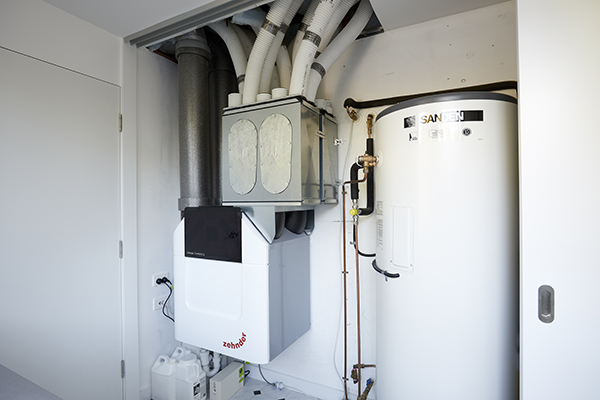How HRV Enhances Indoor Air Quality and Healthy Living
Wiki Article
The All-Inclusive Guide to the Uses of Heat Recovery Ventilation in Modern Buildings
Heat Recovery Ventilation (HRV) systems represent a substantial improvement in building technology (HRV Heat Recovery Ventilation). They provide an approach for exchanging stagnant interior air with fresh outside air while reducing power loss. This method not just improves interior air high quality yet likewise adds to power efficiency in both property and commercial structures. Understanding the numerous applications and benefits of HRV can expose its important role in modern-day design and sustainability efforts. The effects of this innovation deserve exploring even moreRecognizing Heat Recovery Ventilation Solutions

Numerous contemporary structures focus on power performance, comprehending warm recuperation air flow (HRV) systems is vital for optimizing indoor air high quality and minimizing power intake. HRV systems work by transferring warm from stagnant interior air to inbound fresh air, properly keeping comfy interior temperature levels while minimizing power loss. These systems include a warmth exchanger, followers, and ductwork that promote the blood circulation of air. During winter season, HRV units capture and reuse heat from the outward bound air, while in summer season, they can aid cool down inbound air. By continuously trading air, HRV systems likewise minimize humidity and the focus of indoor contaminants. Appropriate installment and upkeep of HRV systems are crucial for their performance and performance in improving total building efficiency and convenience.
Advantages of Heat Recovery Ventilation
Heat recovery ventilation systems offer various benefits that enhance both energy performance and interior air high quality in modern buildings. By capturing and recycling power from exhaust air, these systems substantially decrease heating and air conditioning prices, bring about lower energy consumption. They maintain a constant flow of fresh outdoor air, lessening the danger of interior air contaminants and allergens. This constant exchange helps manage humidity degrees, avoiding mold and mildew development and guaranteeing a much healthier living atmosphere. In addition, HRV systems add to sustainability objectives by decreasing general carbon impacts. Their capability to optimize air flow without giving up thermal convenience makes them a valuable enhancement to modern structure layout, promoting both financial and ecological benefits.Applications of HRV in Residential Structures
As property owners significantly prioritize power performance and indoor air top quality, the applications of warm recuperation ventilation (HRV) systems in domestic structures have actually become a lot more prevalent. HRV systems are especially advantageous in snugly sealed homes, where preserving fresh air circulation is necessary for preventing moisture accumulation and interior toxins. They effectively transfer heat from outbound stagnant air to inbound fresh air, decreasing energy prices connected with heating & cooling. Additionally, HRVs can enhance convenience degrees by controling humidity and temperature level. They are likewise versatile for different household designs, including single-family homes and multi-unit structures. On the whole, incorporating HRV systems sustains sustainable living practices while guaranteeing a healthier indoor environment for residents.HRV in Commercial and Industrial Setups
In commercial and commercial Home Page settings, the application of heat recuperation air flow (HRV) systems has actually come to be increasingly important for enhancing energy efficiency and preserving air top quality. These systems efficiently transfer heat from exhaust air to incoming fresh air, decreasing the requirement for additional heating or air conditioning. This not only decreases energy costs but also adds to sustainability efforts. Industries such as manufacturing, warehousing, and office complex profit considerably from HRV systems, as they assist regulate temperature level and moisture degrees, guaranteeing a comfortable and productive setting. HRV systems help in eliminating pollutants and excess wetness, improving indoor air quality. As laws around air quality come to be stricter, the adoption of HRV modern technology is likely to expand, making it an essential component of contemporary industrial and commercial facilities.Future Fads in Heat Recovery Ventilation Modern Technology

Regularly Asked Questions
Just How Does Heat Recovery Ventilation Influence Indoor Air High Quality?
Heat recovery ventilation substantially enhances interior air high quality by continually exchanging stale indoor air with fresh outdoor air while recuperating power. This process lowers contaminants, preserves optimal humidity levels, and guarantees a much healthier atmosphere for residents.Can HRV Equipments Be Set Up in Existing Structures?
HRV systems can without a doubt be mounted in existing buildings. Retrofitting may call for alterations to ductwork and ventilation layouts, yet it significantly improves energy effectiveness and interior air top quality, making it a feasible choice for older structures.What Upkeep Is Required for HRV Equipments?
read
Are There Certain Climates Where HRV Is More Efficient?
Heat recovery ventilation systems are specifically reliable in climates with considerable temperature level differences between periods. These systems enhance energy performance by recuperating warmth from exhaust air, making them perfect for both cold and moderately warm atmospheres.Exactly How Do HRV Equipments Affect Power Bills?

Report this wiki page